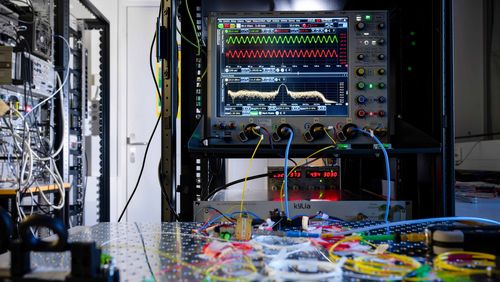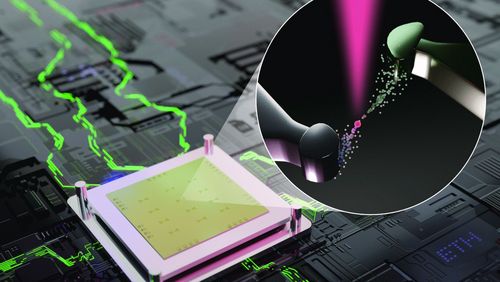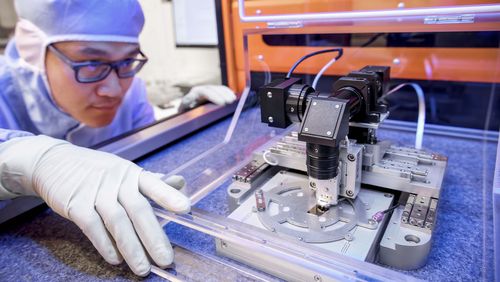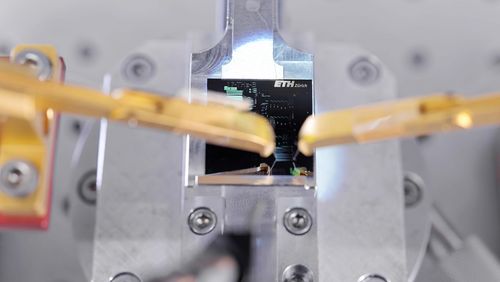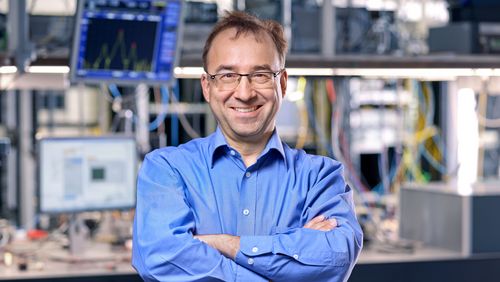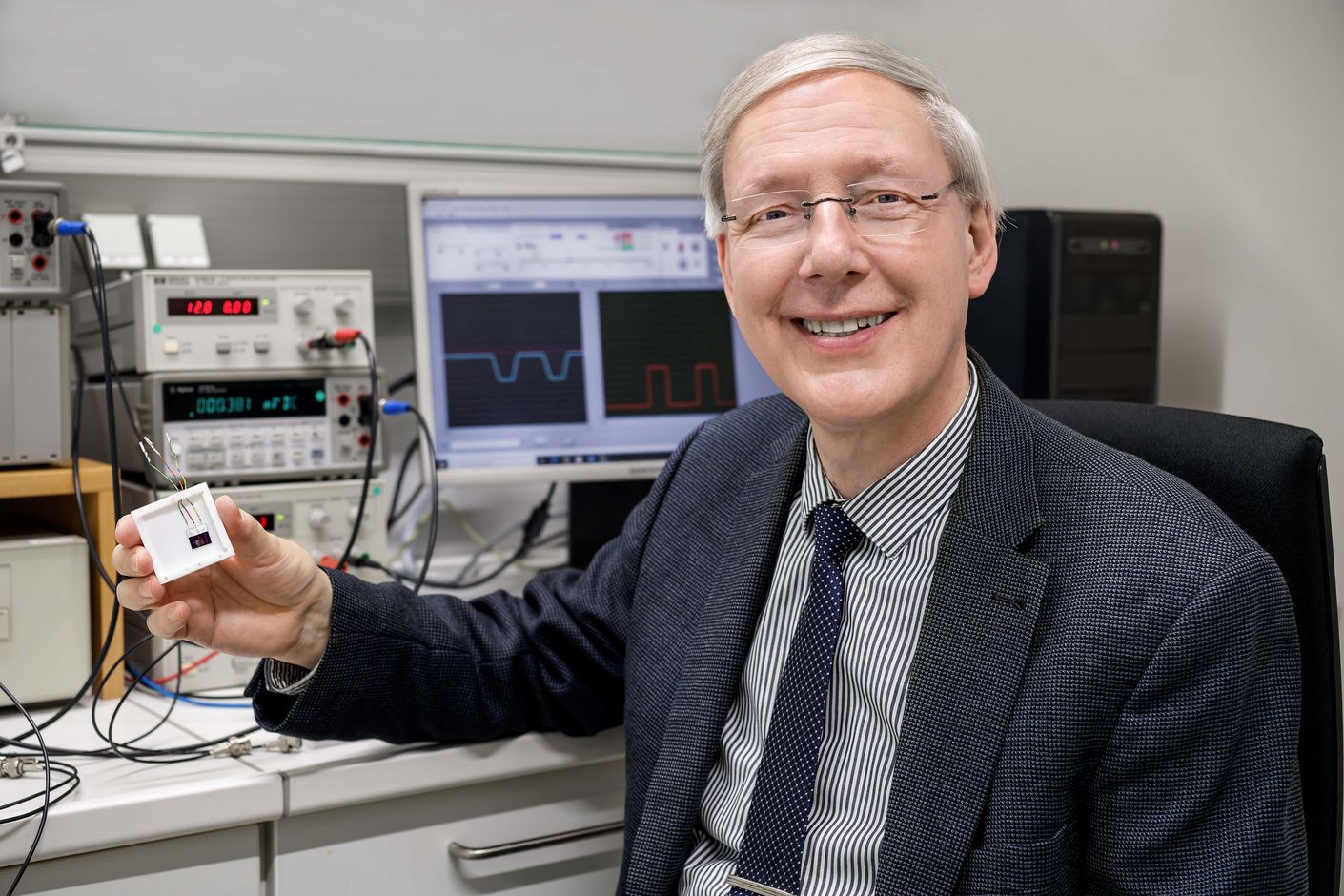
A close-up of the single-atom switch is found further down in the text.
Tin tops silicon
The single-atom transistor developed by physicist Thomas Schimmel has the potential to reduce the massive energy consumption in digital devices by a factor of ten thousand. Moreover, the energy the technology saves could be channelled into boosting the performance of next-generation computers.
Downloading a podcast to our phones for a workout at the gym. Meeting colleagues via Zoom. Streaming a film in the evening. All these conveniences are made possible by a nearly invisible, yet mighty electronic component: the transistor. There are billions of them on microchips, and these transistors are what enable our digital devices to do the actual work of computing.
This much is clear. But today’s transistors have a major drawback: they require a massive amount of energy to process data. “Data communications and processing account for more than ten percent of global electricity consumption in industrialised countries,” says nanotechnology expert Thomas Schimmel at the Karlsruhe Institute of Technology. “If the internet were a country, it would be the sixth-largest energy consumer in the world.”
Single-atom technology
Professor Thomas Schimmel is a research partner in the single-atom switch project conducted at the Swiss Federal Institute of Technology Zurich (ETH Zurich); the project receives funding from the Werner Siemens Foundation. Schimmel is considered a pioneer in single-atom electronics; in his Karlsruhe lab, he invented a mind-bogglingly efficient single-atom transistor that could significantly lower energy consumption in computers. Now, he is collaborating with the teams of his ETH Zurich colleagues, Professor Jürg Leuthold (project leader) and Professor Mathieu Luisier, to translate the innovative invention into practical application.
Much like a normal light switch, the single-atom transistor consists of a switching element and two tiny electrodes that are separated by a gap; here, however, the incredibly narrow opening has the diameter of just one atom. When the switch is turned on, a single metal atom is flipped into the gap, closing the circuit. The resulting flow of electricity can be used to power common electronic devices—for example, a halogen lamp, as Schimmel has demonstrated in his Karlsruhe lab.

Lowest control voltage
A control voltage is responsible for moving the atom, thus for turning the single-atom switch on and off. And the control voltage needed to operate the single-atom switch is one hundred times lower than what is required for today’s silicon semiconductors. Schimmel and his team have also succeeded in radically reducing the voltage from some thirty millivolts in their first single-atom switch prototype to a mere three-to-six millivolts in the latest version.
The ratio between voltage and energy consumption is exponential rather than proportional. This means that when voltage is reduced by a factor of ten, energy consumption decreases by a factor of one hundred. As such, the single-atom switch already uses ten thousand times less energy than today’s silicon semiconductor technology.
Tin instead of silver
The researchers achieved the energy reduction by making electrodes out of tin rather than silver. “We first used silver, because it was the easiest way to realise the single-atom transistor,” Schimmel explains. But then, he and his team began testing the physical and electrochemical properties of other metals, paying particular attention to their viability for single-atom technology. “Our single-atom transistor made of tin is a true milestone in our research,” says Schimmel.
In addition to conducting applied research for developing the novel, energy-efficient transistor, the team are also exploring fundamental questions in physics. For instance, they have observed that a single atom’s conductivity is not a fixed quantity; rather, it depends on the atom’s environment and its structural organisation in a collective with other atoms. “This fundamental understanding is critical, as it’s key to finding a technological application,” Schimmel says, adding that, “we can only control what we understand”.
Indeed, the step from lab prototype to mass production is a major challenge and numerous issues must first be resolved. Of particular importance is how single-atom transistors can be switched simultaneously on a large scale in order to perform the logical operations required of a computer chip. Schimmel and his team plan to address this question next.
Boosting performance
Schimmel is convinced that the single-atom transistor has the potential to revolutionise the digital world in another way, too. Silicon semiconductor technologies have nearly exhausted their capacity to improve performance; any increase in their computing power will make redirecting waste heat more difficult, and cooling semiconductor chips in computers will become a major problem.
With the single-atom transistor, however, the ten-thousandfold reduction in energy consumption could be converted towards boosting performance. Schimmel explains: “If we lowered energy consumption by even just a factor of one hundred, we could still use the reserve energy to increase the world’s overall computing power by a factor of one hundred.”
Text: Cornelia Eisenach
Photos: Felix Wey


